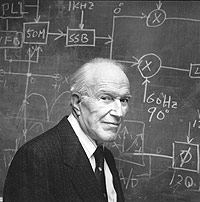 Very early on the 16th of November, at the age of 97, Britton Chance died quietly, at peace in the Hospital of the University of Pennsylvania. He was spirited and still scientifically active right to the end. He is survived by his wife, Shoko, sixteen children, twenty-eight grandchildren, and five great-grandchildren.
Very early on the 16th of November, at the age of 97, Britton Chance died quietly, at peace in the Hospital of the University of Pennsylvania. He was spirited and still scientifically active right to the end. He is survived by his wife, Shoko, sixteen children, twenty-eight grandchildren, and five great-grandchildren.
As many of you all know, Brit lived a storied life in science and engineering and sailing; there are mountains to reflect upon. He has been associated with Penn since the nineteen thirties. By the end of the thirties, while still in his twenties, he had invented the now standard stopped flow device to measure enzyme reaction times in scattering biological materials and had proved the existence of the enzyme-substrate complex in enzyme action. During the forties Brit became the second Director of the Johnson Research Foundation. In the fifties he started and became Chair of the Department of Biophysics and Physical Biochemistry to open the Johnson Foundation to graduate student training. Renamed when it joined with Biochemistry in the seventies, Brit surely cast the die for the adventurous style and high quality of research pursued today in the Department of Biochemistry and Biophysics and Johnson Foundation. After he “retired” to become emeritus in the early eighties Brit launched a new set of research initiatives in biological imaging including in the nineties, the creation of optical diagnostics now an burgeoning field at the interface of basic science, technical development and clinical application. This includes use of imaging systems to detect breast tumors, hemorrhage deep within tissues, and human brain function in cognitive activity. His work has been honored in many ways. He has long been a member of the US National Academy of Sciences, the American Philosophical Society and, like Ben Franklin before him, a Foreign Member of the Royal Society of London. In 1974 he was awarded the National Medal of Science and numerous other honors and international prizes have followed. His generosity closer to home is reflected in his founding of the Chance Chair for the Department of Radiology. This and his many contributions to the School of Medicine and University are recognized by the naming of the Stellar-Chance Laboratories at the dedication in 1995. And from start to finish he sailed, picking up a gold medal at the 1952 Summer Olympics in Helsinki on the way!
Please hold Brit, Shoko and family in your thoughts at this time. If your thoughts should turn to sending flowers, Shoko suggests that gifts in Brit’s memory be made to the Johnson Research Foundation. Donations should be made payable to the Trustees of the University of Pennsylvania and should indicate that the gift is for the Johnson Research Foundation. The address is as follows: Penn Medicine Development, Suite 750, 3535 Market Street, Philadelphia, PA 19104-3309.
